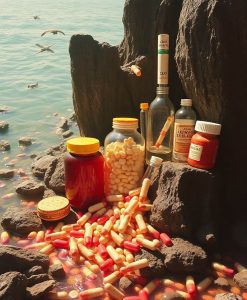When you step into a river, you might feel the coolness of the water against your skin or hear the gentle rush as it weaves past stones and plants. But beneath that surface, an unseen current is quietly carrying a heavy burden — antibiotics from human use, flowing through the water in concentrations high enough to change the very fabric of aquatic life and even our health. It’s a silent, persistent wave that’s reshaping our relationship with nature and medicine, one that often goes unnoticed but demands our awareness.
In the gentle swirl of a river, it’s easy to forget the complex journey that water takes from our homes, hospitals, and farms to the places where it meets the natural world. Every time we use antibiotics, whether for a stubborn infection or as a precaution, a portion of those drugs doesn’t stay confined within our bodies. Instead, they exit through waste, passing through wastewater treatment systems that often aren’t equipped to fully remove these pharmaceutical residues. The result? Tens of thousands of tons of antibiotics silently seep into rivers around the globe each year.
How antibiotics from human use are contaminating rivers worldwide
Imagine the river as a living, breathing artery of the planet. It carries not just water, but the stories of everything that touches it — including our most advanced medicines. The recent study estimates that about 8,500 tons of antibiotics, nearly one-third of what people consume annually, end up in rivers across the globe annually. This means that even as we rely on antibiotics to safeguard our health, we are inadvertently turning our waterways into reservoirs of drug residues that can promote drug resistance and threaten aquatic ecosystems.
This contamination isn’t just a distant problem for communities far away; it’s a global concern that touches every corner of the earth. From the rivers running through densely populated cities to remote streams in rural areas, the persistent presence of antibiotics in water is a reminder of how interconnected our health, the environment, and our consumption habits truly are. It’s a cycle that underscores the importance of rethinking how we handle pharmaceuticals, waste, and water treatment.
What does this mean for those who cherish the health of our rivers and the creatures that inhabit them? It’s about recognizing the small, everyday choices — properly disposing of unused medications, supporting better wastewater treatment infrastructure, and advocating for policies that reduce pharmaceutical contamination. These steps can help reduce the load of antibiotics in our waterways and slow the development of resistant bacteria that threaten global health.
Living with this knowledge requires a shift in how we see our relationship with medicine and nature. It invites us to become more mindful stewards of the water’s purity and more conscious consumers of antibiotics. Because the rivers, much like our bodies, are delicate ecosystems that require our care and respect. The invisible flow of antibiotics in our rivers reminds us that even the most advanced science cannot fully contain the impact of our everyday actions — but we can choose to change how we interact with the world around us.
Understanding the scale and consequences of antibiotic contamination in rivers motivates us to act with compassion for both human and ecological health. It’s a call to see beyond the immediate relief of medicine and consider the long-term health of our planet’s vital waterways. Because when we protect our rivers, we protect the future of all life that depends on their clean, flowing waters.
Learn More: Antibiotics from human use are contaminating rivers worldwide, study shows

Abstract: Millions of kilometers of rivers around the world are carrying antibiotic pollution at levels high enough to promote drug resistance and harm aquatic life, a new study warns. The study estimated the scale of global river contamination from human antibiotics use. Researchers calculated that about 8,500 tons of antibiotics — nearly one-third of what people consume annually — end up in river systems around the world each year even after passing through wastewater systems.
